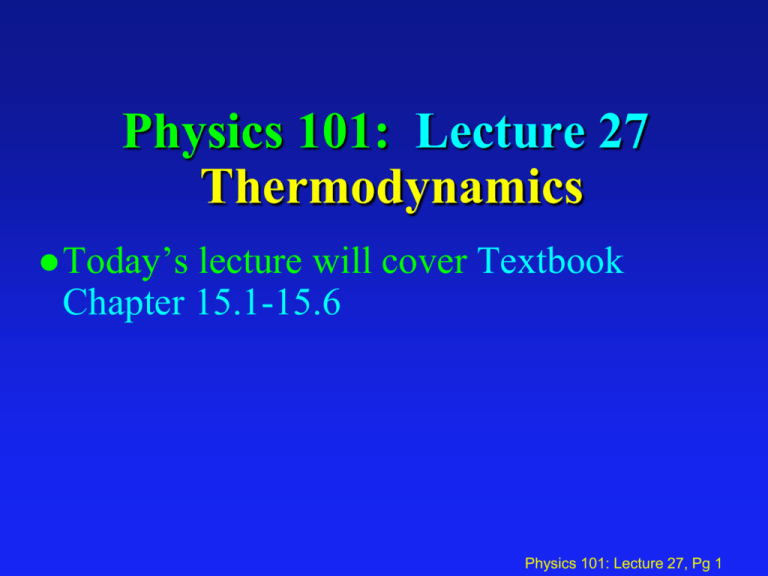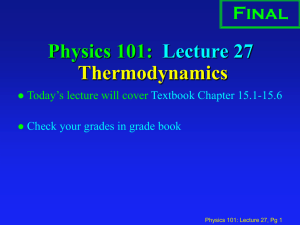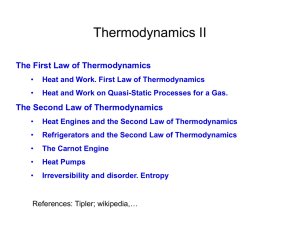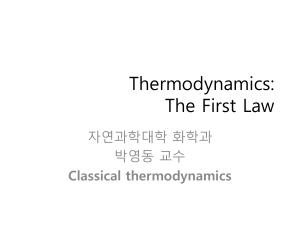PPT
advertisement

Physics 101: Lecture 27 Thermodynamics Today’s lecture will cover Textbook Chapter 15.1-15.6 Physics 101: Lecture 27, Pg 1 First Law of Thermodynamics Energy Conservation The change in internal energy of a system (DU) is equal to the heat flow into the system (Q) minus the work done by the system (W) DU = Q - W ideal gas P P1 P3 1 2 3 V1 V2 V Physics 101: Lecture 27, Pg 2 Signs Example You are heating some soup in a pan on the stove. To keep it from burning, you also stir the soup. Apply the 1st law of thermodynamics to the soup. What is the sign of (A=Positive B= Zero C=Negative) 1) Q 2) W 3) DU Physics 101: Lecture 27, Pg 3 Work Done by a Gas ACT M Dy M The work done by a gas as it contracts is A) Positive B) Zero C) Negative Physics 101: Lecture 27, Pg 4 Thermodynamic Systems and P-V Diagrams ideal gas law: PV = nRT (nR = NkB) for n fixed, P and V determine “state” of system P Examples: which point has highest T? which point has lowest U? P1 A P3 C V1 B V2 V Physics 101: Lecture 27, Pg 5 First Law of Thermodynamics Isobaric Example P 2 moles of monatomic ideal gas is taken from state 1 to state 2 at constant pressure P=1000 Pa, where V1 =2m3 and V2 =3m3. Find T1, T2, DU, W, Q. (R=8.31 J/k mole) P 1 V1 2 V2 V Physics 101: Lecture 27, Pg 6 First Law of Thermodynamics Isochoric Example 2 moles of monatomic ideal gas is taken from state 1 to state 2 at constant volume V=2m3, where T1=120K and T2 =180K. Find Q. P P2 2 P1 1 V V Physics 101: Lecture 27, Pg 7 PV ACTs Shown in the picture below are the pressure versus volume graphs for two thermal processes, in each case moving a system from state A to state B along the straight line shown. In which case is the work done by the system bigger? P(atm) P(atm) A. Case 1 B. Case 2 A B 4 4 C. Same A B 2 2 Case 1 3 Case 2 9 V(m3) 3 9 V(m3) Physics 101: Lecture 27, Pg 9 PV ACT 2 Shown in the picture below are the pressure versus volume graphs for two thermal processes, in each case moving a system from state A to state B along the straight line shown. In which case is the change in internal energy of the system bigger? P(atm) P(atm) A. Case 1 B. Case 2 A B 4 4 C. Same A B 2 2 Case 1 3 Case 2 9 V(m3) 3 9 V(m3) Physics 101: Lecture 27, Pg 10 PV ACT3 Shown in the picture below are the pressure versus volume graphs for two thermal processes, in each case moving a system from state A to state B along the straight line shown. In which case is the heat added to the system bigger? A. Case 1 P(atm) P(atm) B. Case 2 A B C. Same 4 4 2 A B 2 Case 1 3 Case 2 9 V(m3) 3 9 V(m3) Physics 101: Lecture 27, Pg 11 First Law Questions Q = DU + W P P1 Some questions: P3 1 2 3 V1 Which part of cycle has largest change in internal energy, DU ? Which part of cycle involves the least work W ? What is change in internal energy for full cycle? What is net heat into system for full cycle (positive or negative)? V2 Physics 101: Lecture 27, Pg 12 V Special PV Cases Constant W = PDV (>0) 2 4 1 W = PDV = 0 2 Volume 4 3 DV > 0 V 3 DV = 0 Constant 1 Pressure (isobaric) P Constant P V Temp DU = 0 Adiabatic Q=0 Physics 101: Lecture 27, Pg 13 Preflights 1-3 Consider a hypothetical device that takes 1000 J of heat from a hot reservoir at 300K, ejects 200 J of heat to a cold reservoir at 100K, and produces 800 J of work. Does this device violate the first law of thermodynamics ? 1. Yes 2. No Physics 101: Lecture 27, Pg 14 Reversible? Most “physics” processes are reversible, you could play movie backwards and still looks fine. (drop ball vs throw ball up) Exceptions: Non-conservative forces (friction) Heat Flow: » Heat never flows spontaneously from cold to hot Physics 101: Lecture 27, Pg 15 Summary: 1st Law of Thermodynamics: Energy Conservation Q = DU + W Work done by system Increase in internal energy of system Heat flow into system point on p-V plot completely specifies state of system (pV = nRT) work done is area under curve U depends only on T (U = 3nRT/2 = 3pV/2) P V for a complete cycle DU=0 Q=W Physics 101: Lecture 27, Pg 16









